Why Cats Love to Sit in Boxes: The Scientific Explanation
Posted: 11/06/2023 | BY: Erin Cain | Categories: Uncategorized
If you are a domestic cat parent, you’ve probably noticed that your kitty loves to sit inside boxes. It’s not just because they’re cute—there’s actually a scientific explanation for this behavior. This article will discuss why cats love to sit in boxes so much. We’ll also look at some of the benefits of this behavior for both kitties and their owners. Keep reading if you’re curious about why your feline friend loves to curl up in a cardboard box!
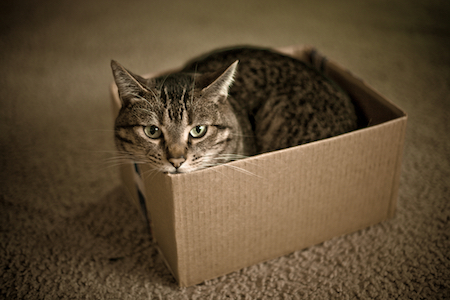
If I fits, I sits.
All cat owners have heard the cat-in-a-box mantra: “If I fits, I sits.” There are some universal truths in the world, and cats loving boxes as long as they can fit — or stuff—themselves into it is one truth you can always count on.
As much as humans may look upon cats’ attraction to boxes as weird, it actually makes sense once you realize how your cat benefits from this type of environment. Here are some reasons why felines love boxes that will demystify this seemingly odd relationship.
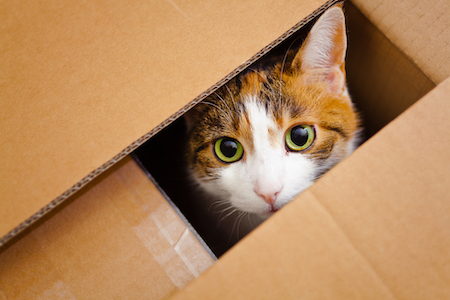
Why do cats love boxes?
While pet parents everywhere get a kick out of watching their cats in boxes — or looking at pictures and videos of other people’s cats in boxes online— there are some sensible reasons why felines gravitate toward enclosed box spaces.
Boxes provide security for cats.
Cats are naturally drawn to enclosed spaces, considering they’re designed for hunting in the wild. It’s instinctual, and when you give your cat her own room, it provides comfort while relieving anxiety. Cats are typically more comfortable when they have something immediately in front of them that can’t be approached from behind or sides. A box provides this security from stressful situations, giving cats protection and calming their anxious feelings while providing comfort due to its shape.
A cat needs somewhere safe where she feels protected but not trapped, and boxes meet both those needs!
Boxes make for excellent hunting spots.
Boxes are great for hiding when cats need to catch unsuspecting prey or sneak up on another cat. The clever cat uses boxes to conceal its presence and sneak up on unsuspecting prey, and that drive is instinctual. A cat who has the chance to ambush prey, as imaginary as the prey may be, is happy indeed.
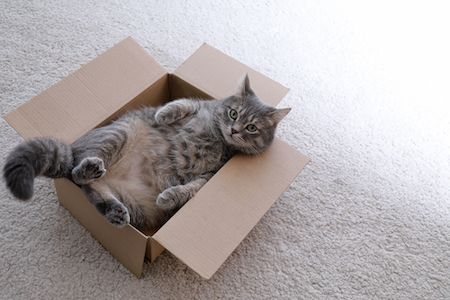
Boxes are great places for cat naps.
Have you purchased fancy, high-quality beds for your cat, only to see her ignore them in favor of a cardboard box? Don’t worry — it’s not you! Boxes are the perfect place for cats to sleep, especially if they also provide some hiding spots. Boxes make enclosures because it is easy for your cat can curl up in them and feel less exposed. Even a cat bed that looks fluffy and comfy can’t compete with a box in terms of darkness and security.
Boxes are ideal for chewing and scratching.
Cats are notorious scratchers, and they can’t get enough of it. Boxes make for great scratching, and kitties love how cardboard feels under those little claws. Cats are very particular about their territory, and when a cat scratches at something, it leaves its own scent behind. If they have a little hiding place, like a box, they will scratch, chew, and lay claim to it.
Boxes are perfect for antisocial cats.
Anyone who has been around cats long enough knows that they are not the best at conflict resolution. Instead of working things out with other cats or pets in the home, easily offended or loner cats are more inclined to avoid conflicts altogether or run away if they can’t. Boxes offer a safe haven and hidey hole of enclosed spaces for antisocial cats. It is a safe zone where the cat can hide from anxiety and unwanted attention until it is gone.
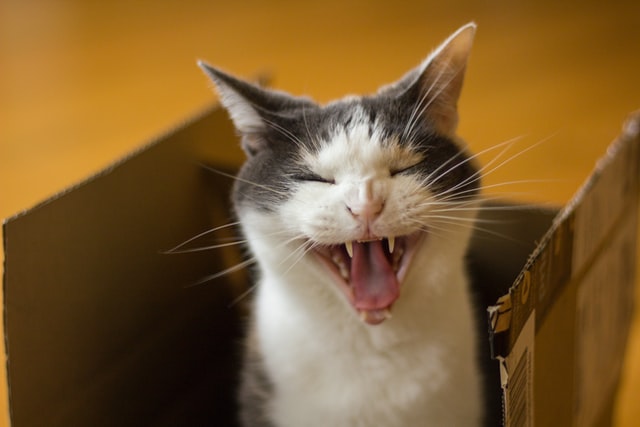
Cardboard boxes keep cats warm.
The minimum temperature for cats to be comfortable is 86-97 degrees Fahrenheit. This contrasts with the typical home, which has an average heat range from 72 -76 degrees, making them colder than what’s optimal for cats. However, a cardboard box provides excellent insulation to keep a cat warm and toasty. Cats have an instinctual need to seek shelter, even if they’re indoors. A cardboard enclosure is a great insulator that helps felines retain their body heat.
Boxes are just plain fun!
A cardboard box is the best toy for cats. Whether they’re rolling around in it, jumping out at their cat parent’s feet, or just playing with toys inside it, your feline friend will enjoy the entertainment a box provides. Additional boxes that can give equal amounts of fun are plastic storage bins, especially when you throw a teaser toy or two into them.
Squares are new and intriguing to cats.
Cats are always on the lookout for new things, so it will grab their attention quickly when you bring something into your home that is entirely unknown to them. A new box will often be examined, played with, and sat in soon after setting it down. Similarly, cats often react to new grocery bags for the same reason.
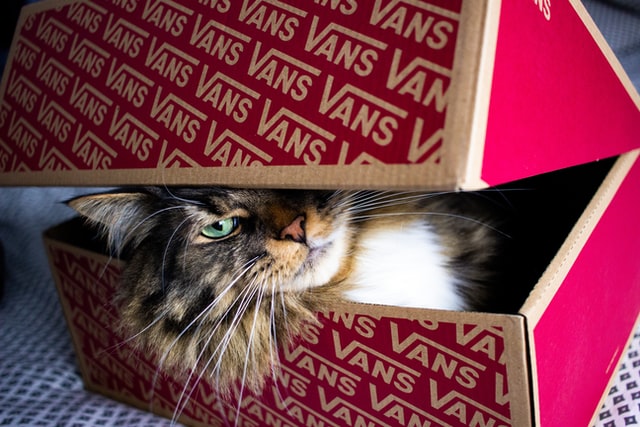
What’s the science behind the box?
In July 2021, a new study was published in the Applied Animal Behaviour Science journal that found that cats are just as willing to sit in a 2-D shape that imitates an illusory square as a regular square. Co-author Gabriella Smith and her team designed an experiment in which pet owners were instructed to create the illusory boxes using paper and masking tape, creating corners without sides. This process is also called the Kanizsa square illusion. The paper gives the perception of edges without the shape being there.
Working with a small sample size of 30 house cats, Smith’s research shows that the majority of the cats chose to sit in the Kanisza illusion as much as they did the square. This study helps researchers learn about how felines perceive visual illusions and their illusory contour susceptibility. It only reaffirms that our cats love anything that looks remotely like a square shape for cat parents!
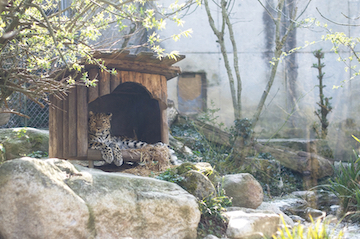
Lions and tigers and boxes, oh my!
The relationship between felines and boxes extends well beyond our domesticated feline friends. Even big cats love boxes! One of the reasons big cats like to sit inside boxes is that it provides them with some security in an enclosed space. For example, lions, tigers, bobcats, leopards, and other wildcats can get inside a small area in captivity. They feel safe from outside dangers, such as predators or rival groups intruding on their territory. Perhaps our domestic cats’ love of boxes is an inherited trait.
Protect your box-loving cat today.
If you’re looking for the best cat health insurance plans, Pet Insurance Review can help. We’ll find a provider and plan that fits your needs — all it takes is giving us some information about yourself and your feline furkid. Cats are notorious for hiding illness and injury, and sometimes we don’t find out what’s wrong until it’s too late. A cat health insurance policy can ensure your cat the best veterinary care possible without the expensive bills.
Cats love boxes, but boxes can only offer so much protection for your cat; a pet insurance plan can do much more. Get a free quote and start protecting your cat today.
References:
- Nuss, A. (2022). 14 Times Cats Proved Cardboard Boxes Are The Absolute Best Spot To Chill Out. Retrieved from https://www.dailypaws.com/cats-kittens/cat-photos/instagram-cats-in-cardboard-boxes
- Morris, J. (2018). Why do cats try to fit into spaces that are much too small? Retrieved from https://www.mercurynews.com/2018/04/03/why-do-cats-try-to-fit-into-spaces-that-are-much-too-small/
- Ambleside Animal Hospital. (2021). 10 Odd Behaviors That Prove Cats Are Wild at Heart. Retrieved from https://amblesideanimalhospital.com/10-odd-behaviors-that-prove-cats-are-wild-at-heart/
- Edwards, M. (2021). Cat Sleeping Habits & How to Create a Safe Sleep Space. Retrieved from https://www.hepper.com/cat-sleeping-habits/
- Chewy Editorial. (2021). Why Do Cats Scratch? Retrieved from https://be.chewy.com/why-do-cats-scratch/
- Smith, G., Chouinard, P., Byosiere, S.E. (2021). If I fits I sits: A citizen science investigation into the illusory contour susceptibility in domestic cats. Retrieved from https://www.sciencedirect.com/science/article/abs/pii/S0168159121001258
- puzzlewocky. (n.d.). Kanisza Square and Triangle Illusions. Retrieved from https://puzzlewocky.com/optical-illusions/kanizsa-square-and-triangle-illusions/
- Berman, R. (2015). Big Cats Need Boxes, Too. Retrieved from https://slate.com/human-interest/2015/11/tigers-lions-and-other-big-cats-love-cardboard-boxes-as-much-as-household-cats-video.html
Disclaimer
The information contained on this blog is intended for informational and educational purposes only and should not be construed as medical advice. It is not a substitute for professional veterinary care. Always consult with your veterinarian before making any changes to your pet's health care or treatment plan.
The authors of this blog are not veterinarians and do not claim to be experts in pet health. The information provided here is based on our own experiences and research, as well as information from reputable sources. However, we cannot guarantee the accuracy or completeness of this information.
We encourage you to do your own research and consult with your veterinarian before making any decisions about your pet's health.
Compare top pet insurance providers plans.
Enter your dog’s age in years and months to calculate their age equivalent to human years.
Calculate your dog’s ageEnter your cat’s age in years and months to calculate their age equivalent to human years.
Calculate your cat’s age